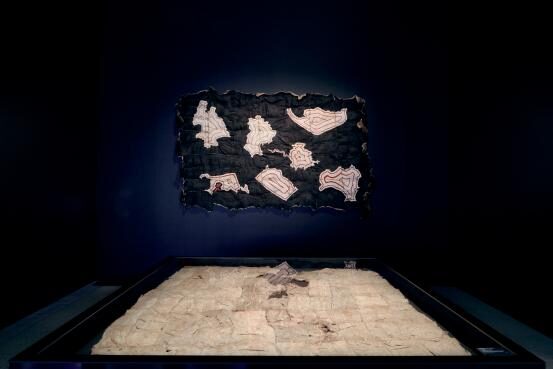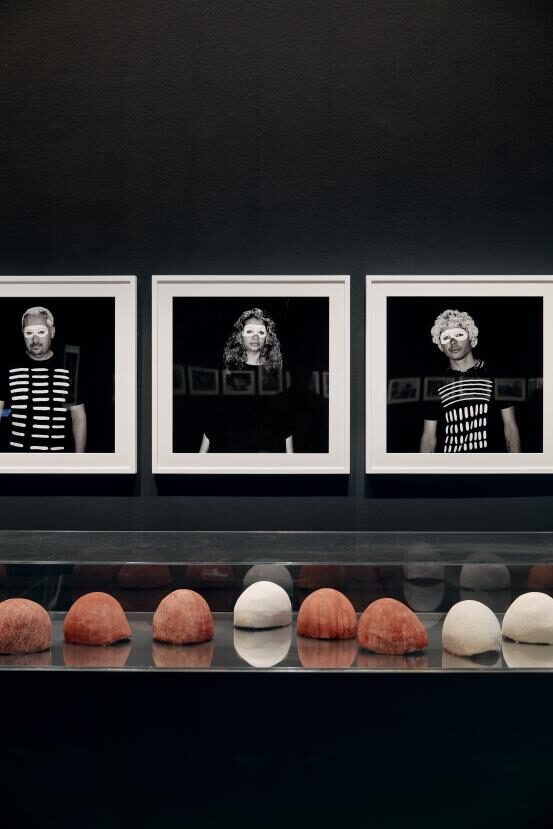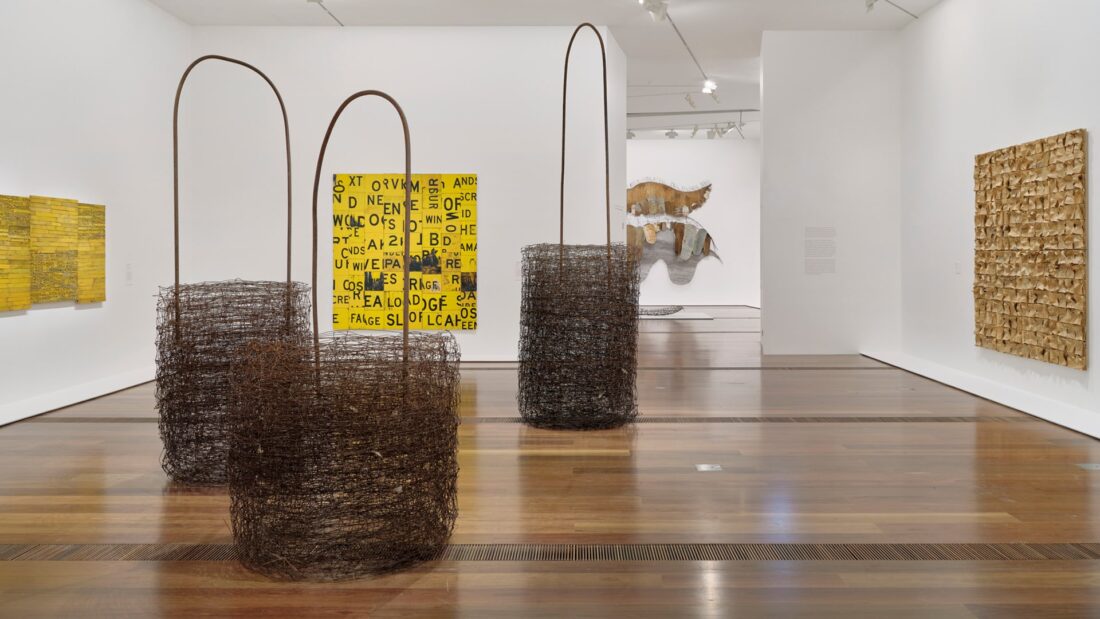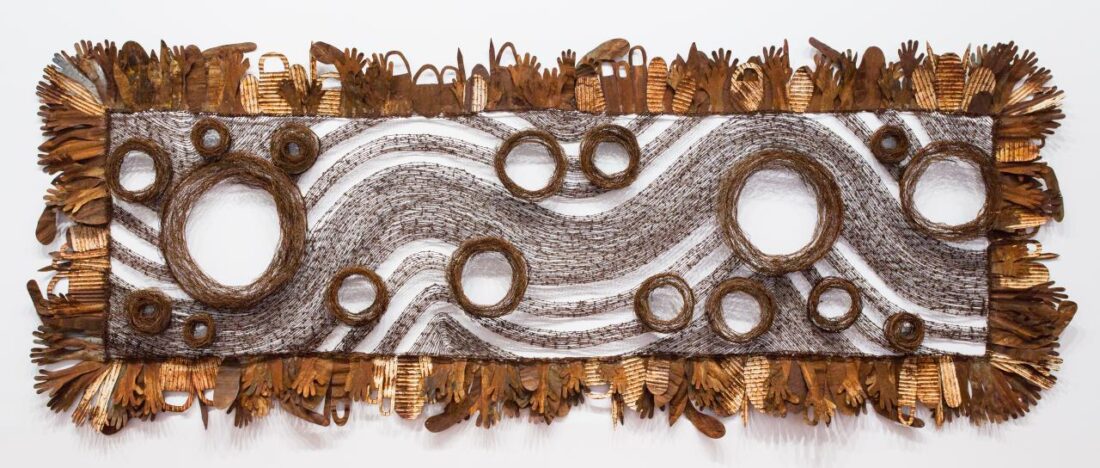From the Head of Arts – Tough Themes Beautifully Handled

Recently, the National Gallery of Victoria: Australia has exhibited some extraordinary female, contemporary, First Nation artists.
The recent Maree Clarke (Yorta Yorta / Wamba Wamba / Mutti Mutti / Boonwurrung) retrospective Exhibition Ancestral Memories, communicated delicately and gently, significant themes of affirmation and reconnection with her cultural heritage.

Installation view of Walert – gum barerarerungar, Maree Clarke, 2021, sixty-three possum pelts and kangaroo tail sinew with Yorta Yorta cloak from the 19th Century.
I was lucky to see the Exhibition in person twice, once moments before lockdown (number forgotten!) and again, when the NGV re-opened. The black walls and softly lit spotlights enhanced the cohesiveness of the vastly different artforms and communicated the subtle sorrow and sadness that emanated from a series of interdisciplinary artworks about South Eastern Aboriginal peoples mourning rituals nearly lost to colonialisation.
Tough themes, beautifully handled. Had to be seen. Twice.

Installation view of Ritual and Ceremony, Maree Clarke, 2021, plaster mourning Kopi caps in the foreground, photographs.
Currently, the Exhibition Found and Gathered, brings together Rosalie Gascoigne and Waradgerie artist, Lorraine Connelly-Northey.

Installation view of the exhibition Found and Gathered: Rosalie Gascoigne | Lorraine Connelly-Northey at The Ian Potter Centre, National Gallery of Victoria: Australia.
Originally gathering reeds for weaving, Connelly-Northey now gathers and uses materials often associated with European industrialisation and waste such as wires, metal sheeting and barbed wire. Her found object artworks reference traditional weaving techniques and Indigenous cultural objects, such as kooliman bags, woven from discarded wire brought back to life.

A Possum Skin Cloak: Blackfella Road, Lorraine Connelly-Northey, 2011-13, corrugated iron, barbed wire
We are reminded of our differing connections with nature and uncomfortably, the disposition of Indigenous people from the land. With International Women’s Day approaching on 8 March, I am encouraged to see the major galleries affirming the significant role of women in arts, as well as creating major exhibitions of contemporary female indigenous artists.
As I was reminded when recently discussing Orwell’s 1984, themes, histories, societal behaviours and commentary, art can be uncomfortable and provoking. Clarke’s work revitalising mourning practices of South East Aboriginal people lost to colonisation is another example. Nonetheless, we learn from experiencing and investing time into these challenging themes and artworks.
We don’t always ‘like’ books like 1984. I don’t always immediately ‘get’ artworks, and there are certainly many that I would not hang on my wall. Contemporary artworks, performances and art experiences can be resistant to being unpacked from an aesthetic point of view. When considering Contemporary Art, we no longer ask ‘Is the artwork good?’ or ‘Is the work aesthetically pleasing?’ Instead, viewers consider whether art is ‘challenging’ or ‘interesting.’
At St Catherine’s School we develop bold learners who embrace discomfort and challenge. Our Arts students have demonstrated this time and again. 2021 VCE Visual Arts students chose themes such as body image, learning disabilities, mental health, racism, homelessness, isolation and loss.
Tough themes, beautifully handled.
Like the National Gallery of Victoria, the Arts Faculty at St Catherine’s School is keen to continue to extend our teaching through facilitating discussions about the history, arts, reconciliation and culture of Aboriginal and Torres Strait Islanders peoples.
Commencing with Unit 1 Studio Arts visiting the current Exhibition Found and Gathered and subsequently using the Exhibition as a starting point for exploring and researching Connelly-Northey’s perspective and ideas.
Year 10 Visual Communication Design will explore Indigenous AFL guernseys as a starting point for a design project about connection, racism and identity. I am excited about an upcoming Masterclass, ‘Possum Cloak Making and Teaching through Art’ with interdisciplinary artist Gunditimara Keeray Woorroong woman, Vicki Couzens.
Drama has designed a new extensive Year 7 project in which students will research events to create dramatic responses, such as how the Stolen Generations had an impact on the course of Indigenous-Australian politics and society. Students’ informed research will then be used as a dramatic starting point.
Embedded further throughout the Drama curriculum are First Nations examples when explaining styles and conventions and using excerpts from scripts by First Nations playwrights. The Music Faculty has also planned to showcase didgeridoo playing.
In 2022 and beyond, we look forward to continuing to develop curriculum that honours reconciliation, the Australian Curriculum and explores themes, ideas, concepts and perspectives that arise from the study of the history, arts and culture of Aboriginal and Torres Strait Islanders people.


